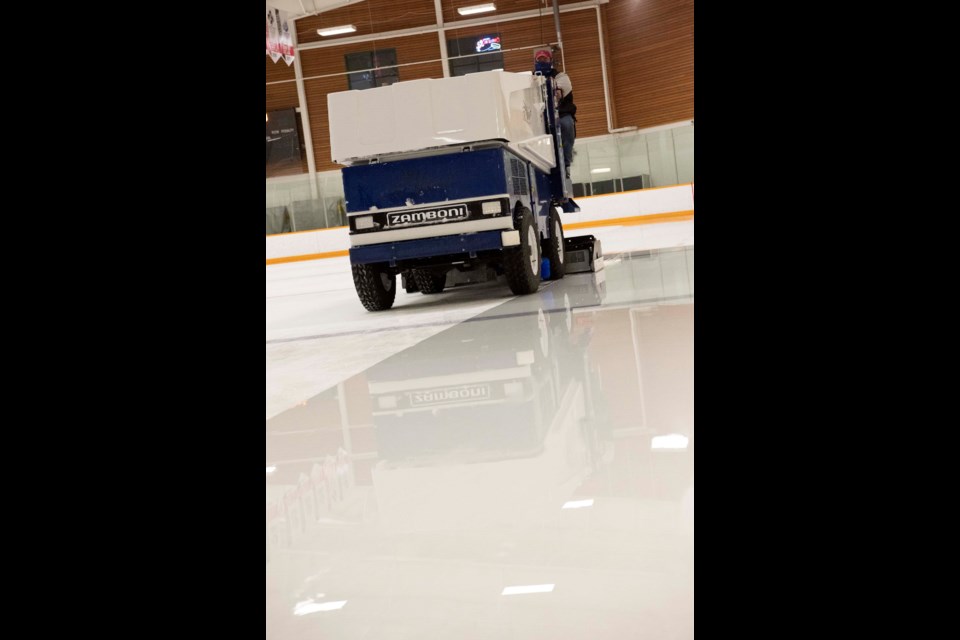Servus Place now has a $35,000 device that’s giving its hockey rinks faster, cheaper and greener ice.
City of St. Albert crews installed a REALice water treatment system at Servus Credit Union Place in January. Indoor sports were banned in Alberta at the time due to the pandemic, so crews didn’t actually put the system into full use until mid-February after the ban was partially lifted.
The city learned about the system from the City of Leduc and decided to test it out at the Mark Messier and Troy Murray arenas, said Christian Benson, city environment manager. Some 600 rinks in North America also use the system.
Zamboni drivers typically use hot and cold water when they resurface a rink, said Benson – cold to fill in cracks and hot to provide a smooth surface. You use hot water for smoothness because the heat releases dissolved gases trapped in water. If not released, those gases create tiny bubbles in the ice (see any ice cube for examples), which makes the ice surface rough and chippy.
You have to burn natural gas to get that hot water, and use more electricity in your cooling plant to turn that hot water into ice than you would if you used cold, all of which means higher costs and more pollution.
“By using this system, you eliminate the requirement for hot water,” Benson continued, and reduce the power needs of your cooling plant.
The REALice system is essentially a teardrop-shaped pipe the length of your arm that slots into the water pipe for a Zamboni, explained Darrell Morin, the city’s manager of recreation infrastructure. The pipe contains channels that spin water into a vortex, concentrating those tiny bubbles into bigger ones that float out of the water without the need for heat.
This gas removal results in stronger, clearer ice that takes less energy to cool and is less likely to create calcium buildup in pipes, according to the REALice website.
Faster, greener ice
The system cost about $35,000, three-quarters of which would be covered by a grant from the Municipal Climate Change Action Centre, Benson said.
He estimated the system should save the city enough money on heat and electricity to pay for itself in a year, while also preventing about 86 tonnes of greenhouse gas emissions a year – equivalent to the emissions produced by driving about 19 cars for a year, the U.S. Environmental Protection Agency reports.
Servus Place Zamboni operator Nathaniel Currey said he is starting to like the new system. It uses a bit more water, but it also makes better ice.
“The ice is faster to skate on,” he said, takes less time to freeze, and produces less snow per skating session.
St. Albert Skating Centre director Don Cowan said his skaters have found the ice to be harder and denser since the new system was introduced, which means more speed for hockey players and more stability for figure skaters (as their skates create smaller holes when they jump). He gave the new ice a thumbs-up.
“Somebody did some proper science behind this!” he said.
Michael Knight, supervisor of arenas for the City of Chilliwack, B.C., said he’s been using REALice at his city’s rinks since 2016 without any problems.
The system has reduced the cooling needs of his pads at the Sardis Sports Complex, shaving about 5,000 hours a year off his compressor run-time and cutting costs. It also lets him resurface rinks with water at 21 C instead of 66 C, which means less gas burned. The only problem he’s had has been traditionalist Zamboni drivers who insist they need hot water for smooth ice.
“I’ve been told I practice witchcraft here,” he joked.
Knight said he plans to use the REALice system in all of Chilliwack’s future arenas and recommended St. Albert do the same with its rinks.
Benson said he hopes to add the REALice device to the Go Auto, Jarome Iginla and Kinex arenas should it prove effective at Servus.




